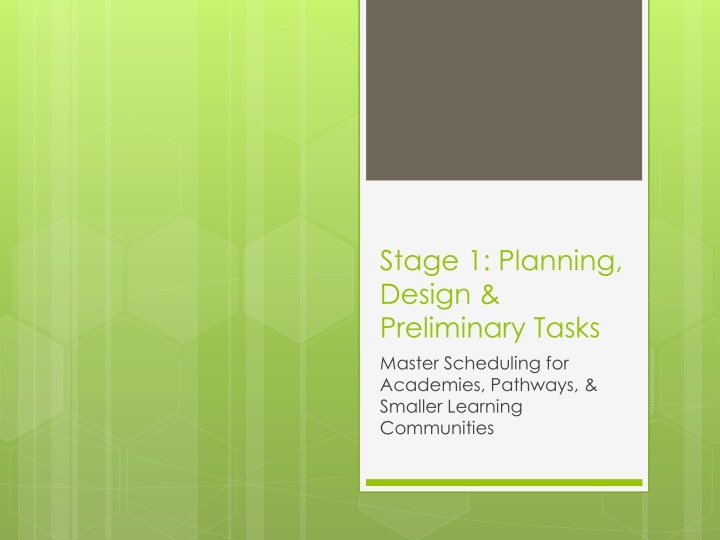
Effective Master Scheduling Strategies for Academic Programs
This comprehensive guide outlines the key steps involved in planning, designing, and scheduling for academies, pathways, and smaller learning communities. From assembling a master schedule team to establishing guiding principles and addressing scheduling opportunities, this resource provides a roadmap for creating a student-centered and equitable master schedule. Emphasizing collaboration and communication among stakeholders, the approach aims to support personalized programs of study and college readiness for all students.
Download Presentation

Please find below an Image/Link to download the presentation.
The content on the website is provided AS IS for your information and personal use only. It may not be sold, licensed, or shared on other websites without obtaining consent from the author. If you encounter any issues during the download, it is possible that the publisher has removed the file from their server.
You are allowed to download the files provided on this website for personal or commercial use, subject to the condition that they are used lawfully. All files are the property of their respective owners.
The content on the website is provided AS IS for your information and personal use only. It may not be sold, licensed, or shared on other websites without obtaining consent from the author.
E N D
Presentation Transcript
Stage 1: Planning, Design & Preliminary Tasks Master Scheduling for Academies, Pathways, & Smaller Learning Communities
Stage 1: Planning Assemble a Master Schedule Team An administrator who can make decisions about courses to be offered and teacher assignments. A counselor who meets with students and knows graduation and college entrance requirements. Non-teaching staff to support student Pathway/course selection and data entry
Master Schedule Team Teachers from one or more Pathway (and one or more Departments) who have an interest in the success of personalized programs of study AND college and career readiness for all Other stakeholders (union rep, parent, student)
A Team Approach A master schedule team that is empowered to make decisions, but also involves all stakeholders in coming to consensus on scheduling principles and priorities.
Planning Guiding Principles Establish a set of Guiding Principles, Priorities, and (possibly) non-negotiables: A commitment to a student-centered, learning- centered master schedule which supports achievement and equity. A commitment to a master schedule that supports interdisciplinary teaching and learning, including project-based learning and other forms of deeper learning. A commitment to a master schedule which is also teacher-centered, supporting time for communities of practice (common planning time)
Planning Guiding Principles A commitment to a schedule that ensures equal access to challenging curriculum, heterogeneous pathways, and flexibility for improved instruction. A master schedule building process that is open, inclusive, transparent, and collaborative. Example: Rigor Relevance Relationships Results
Planning Identify and address any scheduling opportunities, needs, or constraints Dialogue/Communicate about the master schedule plan and process with faculty, staff & other stakeholders Administer Faculty Planning Survey Meet with Pathway Leads/Teams, Department Heads, Pathways and Departments Together Solicit Student Input Communicate, Communicate, Communicate
Stage 1: Planning (continued) Develop and disseminate a Master Scheduling Process and Timeline (who/what/when/as measured by) Review/Update Curriculum and Courses (District- course approval process; course descriptions, catalogue, course codes, ROC/ROP offerings, etc.) Engage stakeholders in Determining Pathway Program(s) of Study AND Course offerings
Stage 1 to Stage 2 In preparation for Stage 2: Begin to Develop Pathway/program of study/course selection/registration packet, process, and timeline As appropriate, develop new course descriptions, obtain necessary approvals, etc.
Planning Recommendations Involve students, parents, district representatives, and the teachers union early in the process. Create charts and other visual representatives. Communicate possible changes, thoughts and decisions.
Sidebar: Some Planning Considerations Will ALL students be in Pathways? Will Pathways include grades 9-12? 10-12? 11-12? Other parameters? Size Matters - optimum Size of a Pathway optimum # of pathways per school - (depending on total school enrollment) Importance of establishing course numbers or tags unique to each pathway)
Sidebar: Some Pathway Considerations To what extent will each Pathway have a distinct program of study (its own curriculum) ? What specific courses (required, elective, or both) will students take inside the Pathway? Outside the Pathway? Will some classes (or course sections) be global open to students from all Pathways?
Sidebar: Some Pathway Considerations Will certain courses be offered in multiple Pathways? OR in all Pathways? (Example: If World Cultures is offered in all Pathways, there will be a way to establish pathway specific course numbers, subscripts, or tags for each pathway-specific World Cultures section) Will some Pathway courses be open to students from other Pathways? (Example: AP Biology in a Health Pathway; AP Physics in an Engineering Pathway, etc.)
Pathway Considerations How will each Pathway Teacher Team share a common planning period that enables the pathway teaching team to function as a community of practice? (entire team; lower division teacher team & upper division teacher team, grade- level team, etc.) Will there be a release period/ coordination period for the Pathway lead teacher?
An Invitation to Share CCASN will continue to add and refine resources and tools included in the CCASN Master Schedule Guide. We invite you to share your own master schedule tools, strategies, and effective practices. Please share resources and suggestions with Patricia Clark (patricia510@gmail.com) and/or Phil Saroyan (jp9@jps.net) THANK YOU.
